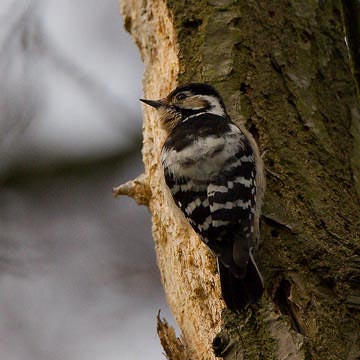
Lesser Spotted Woodpecker © Steve Fletcher
Lesser Spotted Woodpeckers are in trouble. In the last quarter century, across Europe, they have declined more than any other woodland bird. The British population fell by three-quarters from 1984 to 2000, placing them on the Red List, but then they became too scarce to monitor. It is no surprise to see this Atlas ‘change’ map dominated by red dots, with 58 tetrads occupied both in our First Atlas and now, 34 newly occupied since then and 181 holding them twenty years ago but not now. They have been lost from much of the county, with no obvious pattern; previous strongholds north and east of Chester, in SJ37 and SJ46, are deserted now. This is quite a secretive species and might have been under-recorded, but it is likely that the county population now is in the range 50-75 pairs, way down on the estimate twenty years ago of 150 to 250 pairs.
The reasons for the decline are not well established but include competition with, and predation by, the burgeoning numbers of Great Spotted Woodpeckers, and reductions in small-diameter dead wood suitable for foraging. They occupy large home ranges and perhaps landscape-scale changes in woodland, such as loss of mature broadleaved woodland, losses of non-woodland trees such as elms, and woodland fragmentation, may also be important (Fuller et al. 2005). Here in Cheshire and Wirral, Lesser Spotted Woodpecker is close to the edge of its breeding range, which may be contracting. In the atlases of nearby counties it was found in 25% of tetrads in Shropshire (1985-1990), 14% of tetrads in this Atlas, 6% in Lancashire and North Merseyside (1997-2000) and 0.4% in Cumbria (1997-2001).
The submitted habitat codes for this Atlas showed 74% of records in woodland, mostly broadleaved or mixed woodland, with none in coniferous but a significant figure of 11% in waterlogged (carr) woodland – the third highest proportion of any species, behind Willow Tit and Woodcock. Just 3% of records were from scrub, with 12% farmland and 11% human sites. Although they share some habitat characteristics with Willow Tit, the species’ distributions in the county are very different.
In the breeding season they are highly territorial, defending a large area of 50-100 ha and individual birds usually show life-long fidelity to the territory where they first settled. Both sexes participate in the parental duties, with males often taking the larger share. Lesser Spotted Woodpeckers nest late, starting just after oak buds burst, probably because in the breeding season they switch from their normal diet of insect larvae living in dead wood and eat, and feed their chicks on, almost exclusively surface-living insects, especially caterpillars, picked from the foliage and bark of trees (Wiktander et al 2001a).
Proof of breeding was obtained in only 14 tetrads, two from fieldworkers seeing adults carrying food for their young, seven from observations of recently fledged young, and five where nests were found. Unfortunately, no-one recorded the species or condition of any of the nesting trees. Especially in view of their major decline, this would be a worthwhile addition to our knowledge, and it would be good for CAWOS to solicit such information with records of Lesser Spotted Woodpeckers. This species depends on dead trees much more than the other two woodpeckers do, with three-quarters of nests in dead wood (Glue & Boswell 1994).
From work in Sweden, the recommendation for conservation of Lesser Spotted Woodpeckers is to have a minimum of 40 ha of woodland dominated by deciduous trees, which may be fragmented over a maximum of 200 ha (half a tetrad) (Wiktander et al 2001b). Few parts of the county approach that prescription.
Sponsored by Peter Day

